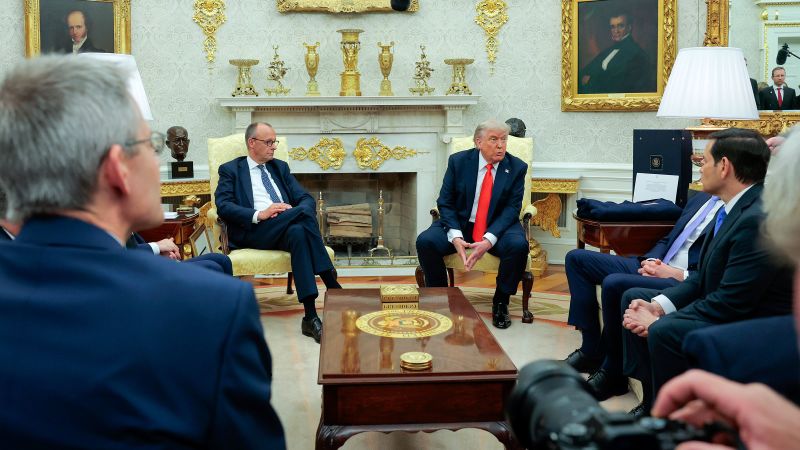In recent months, the discourse surrounding the conflict in Ukraine has brought President Donald Trump to a crossroads of diplomacy and public rhetoric. Historically, Trump has expressed a robust belief in his unique capacity to mediate and resolve the ongoing war. However, as the situation on the ground has grown increasingly dire—accompanied by escalating drone strikes and firmly entrenched positions from both Ukraine and Russia—his initial optimism appears to be giving way to a more somber view of the conflict.
During a recent encounter in the Oval Office with German Chancellor Friedrich Merz, Trump drew a curious analogical comparison, suggesting that the ongoing conflict resembles two children engaged in a fierce fight. In his terms, attempting to intervene prematurely does not always yield positive results. “Sometimes you see two young children fighting like crazy,” he remarked. “They hate each other, and they’re fighting in a park, and you try and pull them apart. They don’t want to be pulled. Sometimes you’re better off letting them fight for a while and then pulling them apart.” This analogy starkly illustrates his current stance, wherein he perceives himself not as a mediator but rather as an observer, allowing the dispute to unfold for a time before intervening.
This shift in tone is significant for Trump, who has gone from asserting that he could instigate a resolution to the conflict within a mere day, to affirming a more laissez-faire approach. His lack of enthusiasm for implementing new sanctions against Russia and hesitancy regarding military aid for Ukraine further exemplify this evolution. Trump has been cautious, navigating the delicate balance of not pushing Russian President Vladimir Putin too far away from negotiations. This is indicative of a larger strategy aimed at finding a resolution, albeit one that may take longer than he initially anticipated.
A notable timeframe he previously set for gauging Putin’s commitment to peace negotiations—two weeks—has receded from the public dialogue, suggesting the absence of any imminent action leading up to the self-imposed deadline. This atmosphere of hesitance sets the stage for upcoming international engagements where Trump must confront allies pushing for stronger resolutions regarding support for Ukraine.
The upcoming Group of Seven (G7) summit in Canada offers a particularly important platform for discussions, and it’s anticipated that Trump will meet Ukrainian President Volodymyr Zelensky in person, who has consistently advocated for military support from Western allies. Historically, the G7 has acted as a pivotal advisory entity for Ukraine, and this year’s conference may prove pivotal given Trump’s less active engagement on new sanctions against Russia.
Additionally, a NATO summit scheduled shortly thereafter poses another forum where Trump’s commitment to supporting Ukraine will be scrutinized. Allies are eagerly seeking a dose of transparency regarding Trump’s distinctive approach to NATO, one that has often been skeptical.
Despite earlier statements reflecting a seemingly detached perspective regarding the war, Trump attempted to project support for peace, reiterating his position against violence. However, his casual demeanor during discussions with Merz indicated a new level of resignation concerning the complexities of international conflict. The mention of historical precedents, such as the American intervention during World War II highlighted by Merz, did little to sway Trump’s current stance.
He expressed skepticism about the comparison, joking that it was “not a pleasant day” for Germany during D-Day and remained lukewarm towards the notion that America is once again poised to play a significant role in resolving European conflicts.
Interestingly, Trump’s remarks could denote a willingness to impose sanctions on both Ukraine and Russia if the conflict persists, stating, “We’ll be very, very, very tough, and it could be on both countries to be honest. You know, it takes two to tango.” This approach reflects his broader worldview of equitability in international relations, where he holds both parties accountable for ongoing hostilities.
Hence, while Trump’s public narratives may fluctuate between optimism and resignation, they ultimately underscore the intricacies and challenges that accompany international diplomacy in resolving protracted conflicts. The coming weeks promise to be pivotal as international leaders seek to navigate a path towards peace amidst complex geopolitical dynamics.



